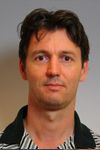Interview with SHM researcher, Ferdinand Wit

Could you tell us a little about yourself?
I am a research physician and have been working in the HIV/AIDS field for 20 years now. I work in the Academic Medical Center (AMC) hospital in Amsterdam one day a week as an HIV-treating physician, but most of my time I carry out clinical and epidemiological research. Before joining SHM as a researcher in November 2015, I worked at the Amsterdam Institute for Global Health and Development (AIGHD).
How did you become interested in HIV?
It wasn’t really something I planned, it was more a matter of chance. During my last internship in 1995, I worked in what was then the AIDS ward in the AMC. I was particularly drawn to the patients in this department, and despite, or perhaps because of, the difficulties at the time with achieving effective combination therapy, I felt strongly motivated to work in this field. After my internship in the HIV/AIDS ward, Sven Danner and Joep Lange invited me to stay on and carry out PhD research. This research was a treatment monitoring study into the first experiences with highly-active antiretroviral therapy (HAART). This study was really a forerunner of the ATHENA cohort, in itself the forerunner of SHM. And here I am now, 20 years on.
Why did you choose to combine research with clinical work?
By training I’m a doctor, and so my interest in my work is driven by HIV/AIDS and, of course, my patients. However, during my PhD, I also realised that I really enjoyed carrying out research. I was lucky that the AMC carries out a great deal of clinical research, as well as providing patient care, and that Joep Lange appreciated the added value of a researcher also being directly involved in patient care.
Continuing to combine these two fields was a conscious decision. Because I am active in both fields, I often play a bridging role in large multidisciplinary studies, linking clinicians with epidemiologists or statisticians. Moreover, because I regularly work with observational data, like SHM’s data, I understand what’s involved. For example, I know where the data come from and as a result am also more able to assess the potential and the limitations of observational data. These are also the kind of things I find my non-clinical colleagues here at SHM ask me about.
Why did you choose to join SHM?
I had been working with SHM’s data for quite a while and had always enjoyed this work. However, in practical terms, it was sometimes tricky to work with the data as I had to ensure financing for each particular project. Now that I’m at SHM, it is self-evident I’ll obviously be working far more intensively with these data.
In my previous job I was not only involved in HIV, but also in a large project that focussed on five African countries (the Health Insurance Fund). Within this project I was primarily involved with the studies into the provision of healthcare for age-related diseases, and in particular hypertension. Hypertension and cardiovascular disease are, of course, also one of the main problems in the gradually ageing population of HIV-positive people in the Netherlands, particularly since we also have many patients of African origin in the Netherlands who have a natural tendency towards high blood pressure. So even within this project, there was a link to HIV care and research. All in all, given that my primary interest is HIV and I had a long history of working with SHM, it seemed natural to approach SHM when the vacancy arose.
What are you going to focus on in your work at SHM?
I was already working with a great deal of SHM’s data as part of various projects, such as the Amsterdam-based AGEhIV cohort and the COBRA cohort, and my role in these projects will remain unchanged. In addition, I will be more involved in the annual Monitoring Report. I had previously already worked on the report as a co-author of one of the chapters (HIV-related and non-HIV-related morbidity and mortality), but I will now become the first author of this chapter and will also contribute to other chapters.
I will also be involved in evaluating the kind of data that SHM collects, by looking into whether the collection is still optimal in view of changes in the patient population and treatment options, how we can raise the quality of the data even further, and which data are important to collect, something that changes over time, of course. For example, whereas in the past the focus was on information about virological failure, it has now also become important to monitor whether patients are receiving the right prophylactic medication for conditions such as cardiovascular disease, for which they may be at greater risk.
What will be your biggest challenge at SHM?
I have always been extremely enthusiastic about SHM’s database and I therefore think it’s vital that the database retains its quality and thus its excellent reputation. My challenge will be to help ensure that the database stays as good as it is on the one hand, while on the other hand ensuring that we make the most of the data it holds by carrying out high quality research that’s relevant to HIV-positive patients and HIV healthcare providers in the Netherlands. This could be research that I carry out independently or in collaboration with other countries that have similar cohorts. Since I really enjoy and appreciate the importance of this research, I am thrilled to now belong to the SHM club, rather than simply being a ‘guest’ working on the side-line.
